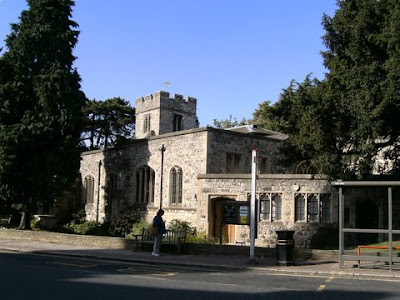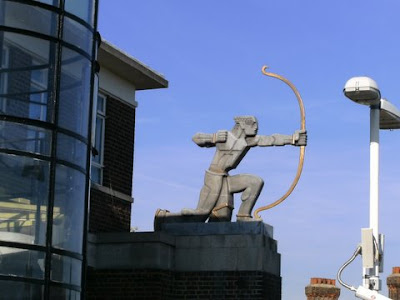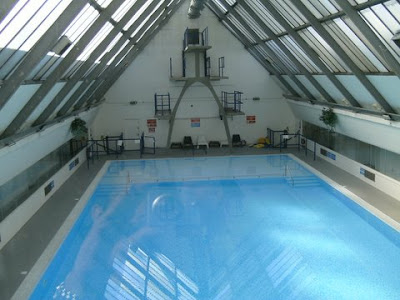Bedford, also known as 'somewhere in England' as that was where the BBC used to broadcast music from during the war years. Why they needed to conceal the location of their concerts is rather baffling- it would have been much better to move them around the country if bombing of classical music - very likely by German or Austrian composers - was seen as a difficulty.
Bedford was also home to much of the parts of the Second World War the Government would rather have kept quiet about. However that sort of stuff is not my interest in
Bedford.
Bedford was home to John Bunyan, the 'chief of sinners' in his words in his spiritual autobiography. His sins don't seem very sinful to us who are much more versed in wickedness than Mr Bunyan. He played games on the village green at
Elstow, enjoyed dancing and rang the bells in the village church. I've indulged in a bit of
tintinabulation myself. I would consider the sin was to those listening to me...
However Bunyan, after hearing a voice say "Wilt thou leave thy sins, and go to heaven, or have thy sins and go to hell?" gave up his sin and decided to live in
Bedford. His preaching eventually landed him in the County Gaol as he was preaching without a licence, at a time when to dissent from the Established church was to deemed to be
traitrous. Bunyan put his time to good use, making bootlaces to support his family and writing the 'Pilgrim's Progress from this world to that which is to
come' a book translated into almost as many languages as the bible, and usually to be found on protestant book shelves even today.
Bedford honours Bunyan and his statue can be found near St
Cuthbert's church (closed when I called). The Bunyan conventicle still meets for worship twice on Sundays.
Bedford does not really honour another religious sect that also has its home there. The last of Joanna
Southcott's followers form the Panacea Society, a charity which is 'a religious organisation with a belief in the latter day prophets and the Second Coming of Our Lord Jesus Christ'.
They hold Joanna
Southcott's box which must be only be opened in the
presence of 24 bishops of the Church of England (the full complement at the time of Joanna
Southcott) and, not surprisingly, they have been reluctant to assemble to do the honours.
The Society believes that a small piece of cloth in a glass of water may help heal all illnesses. They believe the messiah will return to
Bedford.



















 and a pond on the village green, which was used by a Mr Lionel Lukin to test lifeboats.
and a pond on the village green, which was used by a Mr Lionel Lukin to test lifeboats.  Funnily enough the vicar of Romsey from 1860, a Mr Edward Lyon Berthon also designed lifeboats.
Funnily enough the vicar of Romsey from 1860, a Mr Edward Lyon Berthon also designed lifeboats. 

 My usual walk leads from Sholing to Woolston, down to the shore, up to Netley (more later) and back via Mayfield Park. mayfield park has an obelisk in it bearing the legend 'The earth is the LORD'S and the fullness thereof'. It is a memorial to a whig politician although you'd never know it, mostly just an eye catcher in a bleak part of the park. Mayfield park always seems as though it has a time warp in it because walking through it seems to deliver me with speed to my destination (Thanks Jon and Ray!). It's always much quicker than walking towards it.
My usual walk leads from Sholing to Woolston, down to the shore, up to Netley (more later) and back via Mayfield Park. mayfield park has an obelisk in it bearing the legend 'The earth is the LORD'S and the fullness thereof'. It is a memorial to a whig politician although you'd never know it, mostly just an eye catcher in a bleak part of the park. Mayfield park always seems as though it has a time warp in it because walking through it seems to deliver me with speed to my destination (Thanks Jon and Ray!). It's always much quicker than walking towards it.

 Tottenham has Bruce Castle museum within its boundaries, however the opening hours are not for early birds. Wed-Sun 1pm-5pm. So when I arrived at 1100 on Saturday I was disappointed and not really prepared to hang around for another three hours. So I went off to Walthamstow to the William Morris Gallery, which proclaims itself as the only museum dedicated to the life and work of William Morris. William Morris had his childhood home in Walthamstow, when it was nice, and this has been transformed into a museum of his life’s work. This includes furnishing, fabrics, stained glass and wallpaper. The museum also contains pictorial art and a room for temporary exhibitions.
Tottenham has Bruce Castle museum within its boundaries, however the opening hours are not for early birds. Wed-Sun 1pm-5pm. So when I arrived at 1100 on Saturday I was disappointed and not really prepared to hang around for another three hours. So I went off to Walthamstow to the William Morris Gallery, which proclaims itself as the only museum dedicated to the life and work of William Morris. William Morris had his childhood home in Walthamstow, when it was nice, and this has been transformed into a museum of his life’s work. This includes furnishing, fabrics, stained glass and wallpaper. The museum also contains pictorial art and a room for temporary exhibitions. 





